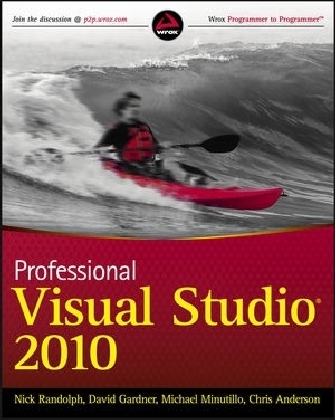
Professional Visual Studio 2010
Wrox Press (Verlag)
978-0-470-54865-3 (ISBN)
- Titel ist leider vergriffen;
keine Neuauflage - Artikel merken
* Digging Deeper: Though the many graphical components of Visual Studio that make a programmer's job easier are discussed in many places throughout this book, you often need help when you're in the process of actually writing code. This part deals with features that support the coding of applications such as IntelliSense, code refactoring, and creating and running unit tests In the latest version of the .NET framework, enhancements were added to support dynamic languages and move towards feature parity between the two primary .NET languages, C# and VB. This part covers changes to these languages, as well as looking at a range of features that will help you write better and more consistent code. * Rich Client and Web Applications: For support building everything from Office add-ins to cloud applications, Visual Studio enables you to develop applications for a wide range of platforms. These two parts cover the application platforms that are supported within Visual Studio 2010, including ASP.NET and Office, WPF, Silverlight 2 and ASP.NET MVC. * Data: A large proportion of applications use some form of data storage. Visual Studio 2010 and the .N
ET Framework include strong support for working with databases and other data sources. This part examines how to use DataSets, the Visual Database Tools, LINQ, Synchronization Services and ADO.NET Entity Framework to build applications that work with data. It also shows you how you can then present this data using Reporting. * Application Services: Through the course of building an application you are likely to require access to services that may or may not reside within your organization. This part covers core technologies such as WCF, WF, Synchronization Services and WCF RIA services that you can use to connect to these services. * Configuration and Internationalization: The built-in support for configuration files allows you to adjust the way an application functions on the fly without having to rebuild it. Furthermore, resource files can be used to both access static data and easily localize an application into foreign languages and cultures. This part of the book shows how to use .NET configuration and resource files.
* Debugging: Application debugging is one of the more challenging tasks developers have to tackle, but correct use of the Visual Studio 2010 debugging features will help you analyze the state of the application and determine the cause of any bugs. This part examines the rich debugging support provided by the IDE. * Build and Deployment: In addition to discussing how to build your solutions effectively and getting applications into the hands of your end users, this part also deals with the process of upgrading your projects from previous versions. * Customizing and Extending Visual Studio: If the functionality found in the previous part isn't enough to help you in your coding efforts, Microsoft has made Visual Studio 2010 even more extensible. This part covers the automation model, how to write add-ins and macros, and then how to use a new extensibility framework, MEF, to extend Visual Studio 2010. * Visual Studio Ultimate: The final part of the book examines the additional features only available in the Premium and Ultimate versions of Visual Studio 2010. In addition, you'll also learn how the Team Foundation Server provides an essential tool for managing software projects.
Though this breakdown of the Visual Studio feature set provides the most logical and easily understood set of topics, you may need to look for specific functions that will aid you in a particular activity. To address this need, references to appropriate chapters are provided whenever a feature is covered in more detail elsewhere in the book. Professional Visual Studio 2010 is for all developers new to Visual Studio as well as those programmers who have some experience but want to learn about features they may have previously overlooked. If you are familiar with the way previous versions of Visual Studio worked, you may want to skim over Part I, which deals with the basic constructs that make up the user interface, and move on to the remainder of the book where the new features found in Visual Studio 2010 are discussed in detail. While you may be familiar with most of Part I, it is worth reading this section in case there are features of Visual Studio 2010 that you haven't seen or used before.
If you're just starting out, you'll greatly benefit from the first part, where basic concepts are explained and you're introduced to the user interface and how to customize it to suit your own style.
Nick Randolph is a Microsoft MVP, owns a mobile specialist development company, Built to Roam, and is an active blogger on the Professional Visual Studio web site (www.professionalvisualstudio.com). David Gardner is the Chief Software Architect at Intilecta Corporation and a regular blogger on the Professional Visual Studio web site (www.professionalvisualstudio.com). Michael Minutillo is a senior .NET developer for Beacon Technology Pty Ltd and currently leads the Perth ALT.NET user group. Chris Anderson is a consultant who specializes in .NET programming.
INTRODUCTION xxxix PART I: INTEGRATED DEVELOPMENT ENVIRONMENT CHAPTER 1: A QUICK TOUR 3 CHAPTER 2: THE SOLUTION EXPLORER, TOOLBOX, AND PROPERTIES 15 CHAPTER 3: OPTIONS AND CUSTOMIZATIONS 33 CHAPTER 4: THE VISUAL STUDIO WORKSPACE 53 CHAPTER 5: FIND AND REPLACE AND HELP 73 PART II: GETTING STARTED CHAPTER 6: SOLUTIONS, PROJECTS, AND ITEMS 89 CHAPTER 7: INTELLISENSE AND BOOKMARKS 119 CHAPTER 8: CODE SNIPPETS AND REFACTORING 137 CHAPTER 9: SERVER EXPLORER 159 CHAPTER 10: MODELING WITH THE CLASS DESIGNER 175 CHAPTER 11: UNIT TESTING 191 CHAPTER 12: DOCUMENTATION WITH XML COMMENTS 219 CHAPTER 13: CODE CONSISTENCY TOOLS 245 CHAPTER 14: CODE GENERATION WITH T4 263 CHAPTER 15: PROJECT AND ITEM TEMPLATES 291 CHAPTER 16: LANGUAGE-SPECIFIC FEATURES 311 CHAPTER 17: WINDOWS FORMS APPLICATIONS 335 CHAPTER 18: WINDOWS PRESENTATION FOUNDATION (WPF) 351 CHAPTER 19: OFFICE BUSINESS APPLICATIONS 379 CHAPTER 20: ASP.NET WEB FORMS 399 CHAPTER 21: ASP.NET MVC 437 CHAPTER 22: SILVERLIGHT 471 CHAPTER 23: DYNAMIC DATA 485 CHAPTER 24: SHAREPOINT 513 CHAPTER 25: WINDOWS AZURE 533 CHAPTER 26: VISUAL DATABASE TOOLS 549 CHAPTER 27: DATASETS AND DATABINDING 559 CHAPTER 28: LANGUAGE INTEGRATED QUERIES (LINQ) 587 CHAPTER 29: THE ADO.NET ENTITY FRAMEWORK 621 CHAPTER 30: REPORTING 645 CHAPTER 31: WINDOWS COMMUNICATION FOUNDATION (WCF) 681 CHAPTER 32: WINDOWS WORKFLOW FOUNDATION (WF) 701 CHAPTER 33: CLIENT APPLICATION SERVICES 725 CHAPTER 34: SYNCHRONIZATION SERVICES 745 CHAPTER 35: WCF RIA SERVICES 757 CHAPTER 36: CONFIGURATION FILES 773 CHAPTER 37: CONNECTION STRINGS 795 CHAPTER 38: RESOURCE FILES 805 CHAPTER 39: USING THE DEBUGGING WINDOWS 827 CHAPTER 40: DEBUGGING WITH BREAKPOINTS 845 CHAPTER 41: DATATIPS, DEBUG PROXIES, AND VISUALIZERS 857 CHAPTER 42: DEBUGGING WEB APPLICATIONS 871 CHAPTER 43: ADVANCED DEBUGGING TECHNIQUES 887 CHAPTER 44: UPGRADING WITH VISUAL STUDIO 2010 905 CHAPTER 45: BUILD CUSTOMIZATION 911 CHAPTER 46: ASSEMBLY VERSIONING AND SIGNING 929 CHAPTER 47: OBFUSCATION, APPLICATION MONITORING, AND MANAGEMENT 937 CHAPTER 48: PACKAGING AND DEPLOYMENT 961 CHAPTER 49: WEB APPLICATION DEPLOYMENT 983 CHAPTER 50: THE AUTOMATION MODEL 1001 CHAPTER 51: ADD-INS 1009 CHAPTER 52: MACROS 1025 CHAPTER 53: MANAGED EXTENSIBILITY FRAMEWORK (MEF) 1033 CHAPTER 54: VISUAL STUDIO ULTIMATE FOR ARCHITECTS 1061 CHAPTER 55: VISUAL STUDIO ULTIMATE FOR DEVELOPERS 1075 CHAPTER 56: VISUAL STUDIO ULTIMATE FOR TESTERS 1095 CHAPTER 57: TEAM FOUNDATION SERVER 1111 INDEX 1139
| Erscheint lt. Verlag | 11.5.2010 |
|---|---|
| Reihe/Serie | Wrox Programmer to Programmer |
| Sprache | englisch |
| Maße | 189 x 233 mm |
| Gewicht | 2014 g |
| Themenwelt | Mathematik / Informatik ► Informatik ► Programmiersprachen / -werkzeuge |
| Informatik ► Web / Internet ► Web Design / Usability | |
| ISBN-10 | 0-470-54865-7 / 0470548657 |
| ISBN-13 | 978-0-470-54865-3 / 9780470548653 |
| Zustand | Neuware |
| Informationen gemäß Produktsicherheitsverordnung (GPSR) | |
| Haben Sie eine Frage zum Produkt? |
aus dem Bereich


